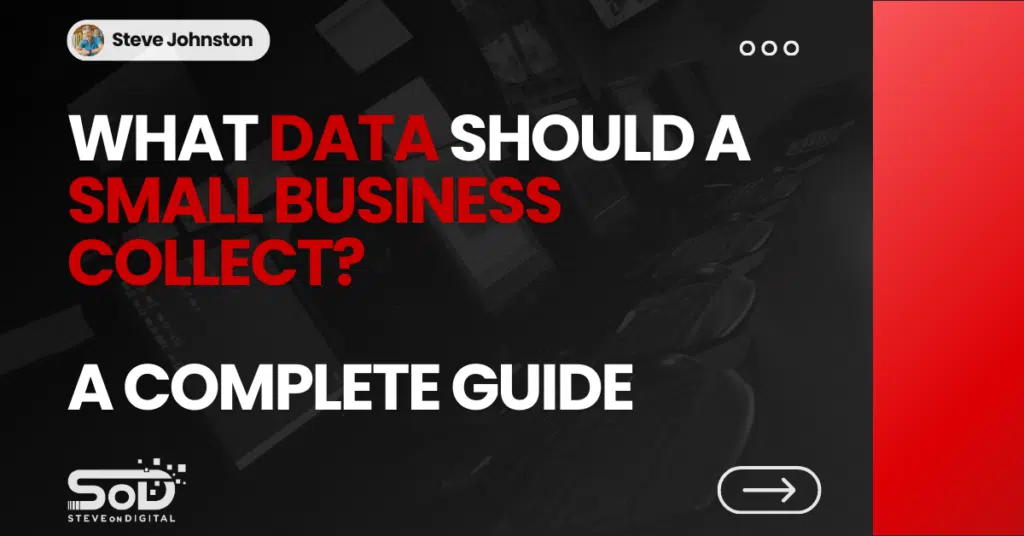What Data Should A Small Business Collect? – A Complete Guide

In my role as a Digital Transformation Specialist, I’ve seen firsthand how crucial data is in understanding market trends and customer behaviors. Data isn’t just numbers; it’s the cornerstone of smart business decisions. By analyzing customer data, small businesses can uncover patterns that inform product development, marketing strategies, and even operational changes. For example, by tracking which products customers spend the most time viewing on your website, you can prioritize stocking those items or promoting them more heavily. But it’s not just about having access to data. It’s about having the right data. In the digital era, where every interaction can be tracked and measured, small businesses can quickly become overwhelmed with the amount of information available. That’s why it’s essential to focus on business decisions that are informed by relevant data points. This approach ensures that you’re not just collecting data, but using it to make informed decisions that directly impact your business’s growth and efficiency. Navigating Challenges In Data Collection Collecting the right data can be a daunting task, especially for small businesses that may not have dedicated data teams. The challenge often lies in knowing which data to collect and which tools to use. For instance, small businesses need to avoid the pitfall of collecting all available data without discerning its relevance. This can lead to costly mistakes, such as investing in marketing strategies that do not align with customer needs or business objectives. Choosing the correct data type to collect is crucial. For my own businesses, SteveOnDigital, StemJee and MindfulTech Institute, I focus on collecting qualitative and quantitative data that directly relates to our operational needs and customer engagement metrics. This selective approach helps prevent the overload that comes from trying to analyze irrelevant data, allowing us to focus on information that genuinely contributes to strategic decision-making. Data collection methods also need to be carefully considered to ensure accuracy and relevance. Secondary data collection, for instance, can be a cost-effective way to gather insights without conducting primary research. However, it’s important to validate the sources and relevance of this data to your specific business context to avoid basing decisions on outdated or incorrect information. Comprehensive Guide To Essential Data Types Customer Acquisition Data Understanding how customers find your business is crucial for optimizing marketing efforts and increasing visibility. In my experience, using online surveys and market research has proven effective in identifying the main channels through which potential customers discover our services. Additionally, tools like Google Analytics offer invaluable insights into customer demographics and behavior, allowing businesses to tailor their marketing strategies more effectively. For instance, by analyzing data collected through Google Analytics, we can see which marketing channels are driving the most traffic to our website and adjust our budget to focus more on those channels. This targeted approach not only saves time but also enhances the effectiveness of our marketing efforts. Customer Engagement Data Once customers find your business, engaging them effectively is key to building lasting relationships. Tracking interactions through your website or physical store can provide critical insights into customer preferences and behavior. Social media analysis and customer feedback are also invaluable data sources for understanding how customers interact with your brand. For example, we regularly analyze feedback collected from social media and other platforms to understand our customers’ communication preferences. This information helps us tailor our outreach and engagement strategies, ensuring that we meet our customers’ expectations and enhance their overall experience with our brand. Customer Retention Data Retaining customers is often more cost-effective than acquiring new ones. Understanding why customers leave—or why they stay—can provide essential insights for improving service and product offerings. Direct feedback and studies on customer purchase history and lifetime value are particularly useful for this purpose. Effective Data Collection Methods Primary Data Collection Techniques In my experience running SteveOnDigital, directly engaging with customers has always been a cornerstone of how we understand their needs and preferences. Here are a few methods we’ve found particularly effective: Secondary Data Collection Practices While primary research is invaluable, secondary data collection also plays a critical role in our overall strategy. Here’s how we approach it: Optimizing The Mix Of Data Collection Methods Finding the right balance between different data collection methods can significantly enhance the effectiveness of our strategies. Here are some ways we achieve this balance: Data Analysis For Strategic Insights Analyzing And Reporting Data Once data is collected, the next step is turning it into actionable insights: Data Security And Ethical Considerations Data security and ethical data management are paramount for maintaining customer trust and complying with legal standards: Leveraging Data To Propel Business Growth Enhancing Customer Experience In my years steering SteveOnDigital, I’ve learned that enhancing the customer experience is key to sustained business success. Here’s how I use data to make that happen: Feedback Theme Common Customer Comments Actions Taken Product Quality “Wish the product durability was better.” Improved material quality in the next batch. Website Usability “Had difficulty navigating the checkout page.” Redesigned user interface to simplify checkout. Customer Service Response “Support was slow to respond.” Implemented a faster, tiered response system. Optimizing Marketing And Sales Efforts Data not only helps in understanding customers but also in refining our marketing and sales strategies to be more effective: Marketing Channel Customer Reach (Monthly Views) Conversion Rate (%) Budget Allocation (%) Social Media 45,000 3.2 25 Email Marketing 30,000 5.1 30 PPC (Pay-Per-Click) 20,000 2.5 20 SEO (Organic Search) 50,000 4.0 25 Strategic Business Decision-Making Data is at the heart of all our strategic decisions, from product development to market expansion: Decision Type Data Utilized Outcome Product Line Expansion Customer purchase history & preferences Launched a new line of eco-friendly products. Inventory Management Sales trend analysis Reduced excess stock by 15%, minimizing waste. Market Entry Consumer demographic and interest data Entered the Asian market, growing sales by 20%. Conclusion Adopting a data-driven culture has been crucial for the growth and resilience of SteveOnDigital: In conclusion, integrating a robust data-driven approach into every layer of your business

